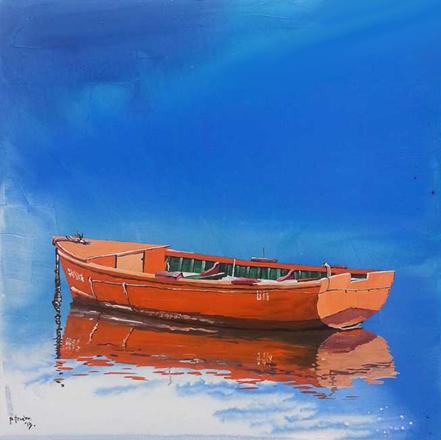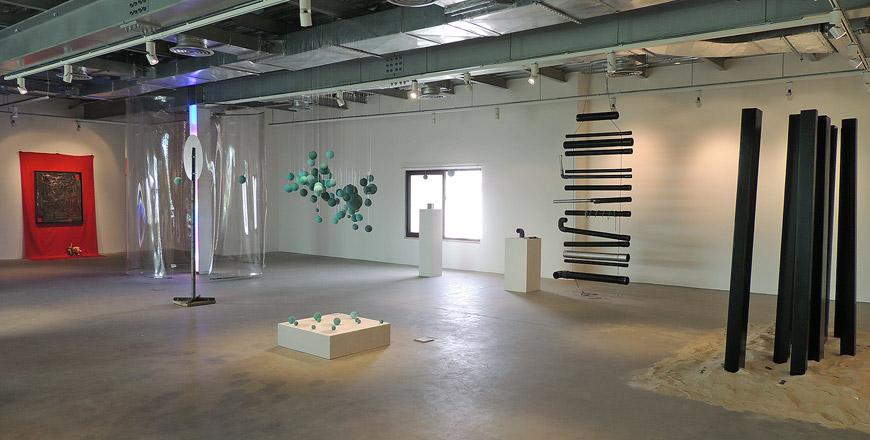You are here
A fusion of realism, contemporary expressionism and abstract
By Ica Wahbeh - Feb 23,2016 - Last updated at Feb 23,2016

Works by Pedro Trueba on display at Instituto Cervantes until March 31 (Photo courtesy of Instituto Cervantes)
Exhibited under the title “Energy and Transformation” at Instituto Cervantes, Mexican artist Pedro Trueba’s works hold true to their promise: they exude intense energy and are executed in different styles and techniques (continuous transformation) to create a world that wishes to “capture the identity and soul of Mexico”.
That is the stated objective of the architect artist whose group of 28 works followed a European-Middle Eastern itinerary, arriving in Amman at the invitation of the Mexican embassy.
“A dream come true,” said Trueba in an interview with The Jordan Times, “an honour to share my work with Jordanians”.
And “the first cultural activity the embassy is organising since we opened here last year”, said Enrique Rojo, Mexico’s ambassador to Jordan.
“It is the first time a modern Mexican artist exhibits his works in Jordan. I hope it is the first of many opportunities to promote Mexican culture as a means to strengthen bilateral ties.”
Since 1991, when he held his first exhibition in Mexico City, where he now lives, Trueba has exhibited his works, which reach an impressive 9,000, numerous times, in his country, the US, Guatemala, Portugal and Switzerland, among others.
Versatile, creative and talented, the artist works in different styles, creating a “fusion of realism, contemporary expressionism and abstract”, all “inspired by energy, transformation and the movement generated in the Mexican space”.
His bold, mostly primary, colours and his mastery of the technique create imagery that is uplifting, engaging and soothing, but, above all, tells a story: of a country and its people, Mexican through and through, but easily of any other place on earth.
Whether entirely abstract, pulsating with life, or delightfully realist, Trueba’s acrylics on canvas speak to the viewer.
Vibrant, powerful primeval nebulae are rendered in bold red, blue, green or orange; the colours vie for primacy, interlace chaotically, explode to create the universe.
Or they get structured, organised, tamed. The wild abstract becomes city or seascape, assumes familiar shapes that wish to “render the space and energy, the history that we live in a city” — Mexico City, in this case — through colours, and succeed.
The artist skilfully makes his abstracts more “understandable”, more attractive by having them support an “object” in the foreground.
The lines delineating the horizon of the cityscape, moored boats or the Papantla fliers anchor the abstract, give it more, or different, meaning, make it palatable and more attractive.
The Papantla flyers — performing a sacred ritual to Quetzalcoatl, a god and legendary ruler of Mexico represented as a feathered serpent, that goes back 1,500 years, to the accompaniment of music — are images to behold.
Hanging from ropes, four young men (“symbolising the four cardinal points” or maybe the four seasons) drop in circular movements down a 30-metre pole in a graceful flight and a blur of colours.
Wearing white shirts and red trousers, and many colourful adornments, the Veracruzan flyers (Trueba’s state of origin) are painted like soaring birds defying gravity, detaching themselves against the stark abstract background, softening it and instilling life in it.
The cityscape, dwarfed by the ether above, is used to render, in striking colours, the actions, dreams and history of the people living there.
The immense vastness of the sea, quite recurrent in the artist’s works, is brought to a scale that man can more easily understand by the presence of boats.
Alone, anchored (like the flyers to the pole), holding a fisherman or a lonely seagull, or moored by a pier and watched by idle onlookers, the boats transport one to faraway places, talk about man’s taming of the formidable nature or of his desire to discover new worlds.
Alternating with the realistic images are yet more abstracts. Blocks of colour create interesting geometric patterns, abstract but not quite, clearly delineated, yet blurred at times — a playful way of rendering texture, movement and depth.
In his over 25 years as an artist, Trueba, a firm “believer in the evolution of art”, used different styles and techniques, experimenting, living up to the speed with which “things happen around us and the happenings that reach us” in no time.
He also believes in the power of art to “educate and heal”.
“We can use art for positive things” is his message, a belief that this part of the world, particularly, would be much better off to accept and adopt.
In Jordan for the inauguration of his exhibition, Trueba visited Petra, Jerash and the Citadel, sites that “will definitely influence my future works”.
Whether in daylight or under the moon, the artist captures life in tiny details or in the grand scheme of things. His images are energetic and stirring; they bring a piece of Mexico to the world, but are also proof of the universality of art.
His works will be on display until March 23.
Related Articles
The Jordan National Gallery of Fine Arts is quite busy this spring.
AMMAN — Music, painting and the human soul have found a place in the work of Jordanian artist Zaid Shawwa, now displayed under the title “Wa
AMMAN — A group art exhibition titled “Arab Heartbeats for Syria” will be donating its proceeds to the Jordan Hashemite Charity Organisation


















